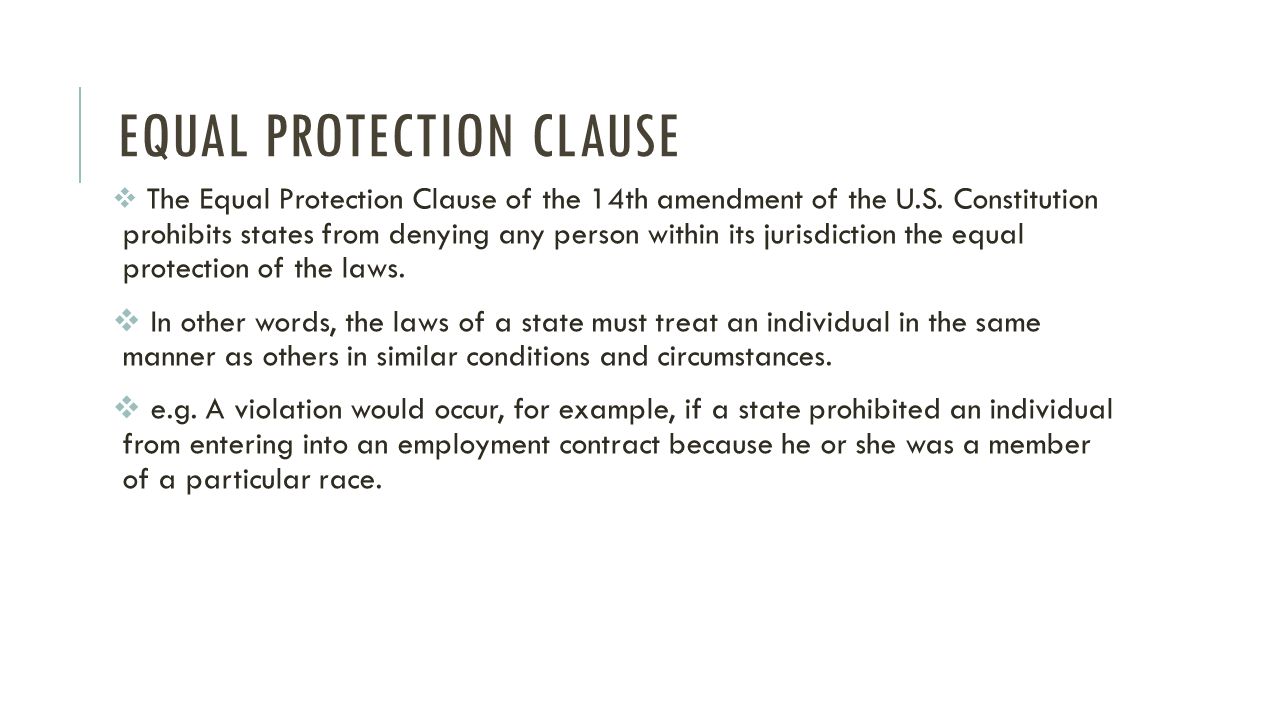The Equal Protection Clause is a provision in the 14th Amendment of the United States Constitution that guarantees equal protection under the law to all citizens. It prohibits state and local governments from denying any person within their jurisdiction equal protection of the laws. This means that the government must treat all individuals in the same manner, regardless of race, gender, religion, or any other characteristic, and must provide equal protection of the laws to all citizens. The Equal Protection Clause has been used to strike down many laws that discriminate against minority groups and has been a cornerstone of the fight for civil rights and equality in the United States.

1. The History of the Equal Protection Clause in America and Why It Matters Today
The Equal Protection Clause is a fundamental part of the 14th Amendment to the United States Constitution, which was added in 1868. The clause states that no state shall "deny to any person within its jurisdiction the equal protection of the laws." This means that all individuals, regardless of their race, gender, religion, or other characteristics, must be treated equally under the law. The clause was added as a response to the rampant discrimination against African Americans during the post-Civil War era, and it was meant to ensure that they would be protected against discrimination and receive equal treatment under the law.
The Equal Protection Clause has been at the center of many landmark court cases throughout the history of the United States. For example, in the landmark case of Brown v. Board of Education, the clause was used to strike down segregation in public schools. In recent years, the clause has also been used to challenge laws that discriminate against LGBTQ individuals and to support the rights of women and other marginalized groups.
Today, the Equal Protection Clause remains a critical tool in the ongoing fight for equality and justice in America. It is essential for protecting the rights and freedoms of all individuals, and for ensuring that the law is applied fairly and equally to all. Despite its importance, the clause continues to be challenged and tested, and it is up to all of us to work to uphold its principles and ensure that the promise of equal protection under the law is realized for all people.
2. How to Understand the Equal Protection Clause and Its Impact on Your Legal Rights Today
This means that all individuals, regardless of their race, gender, religion, or other characteristics, must be treated equally under the law.
Understanding the Equal Protection Clause and its impact on your legal rights today is important because it provides a cornerstone of protection against discrimination. Whether you are facing discrimination in the workplace, in housing, in voting, or in any other aspect of your life, the Equal Protection Clause gives you the right to challenge such discrimination in court.
One way to understand the Equal Protection Clause is to think about it as a safeguard against unequal treatment under the law. This means that if you feel that you have been treated unfairly or discriminated against, you can use the Equal Protection Clause to assert your rights and to fight for equal treatment.
Another way to understand the Equal Protection Clause is to think about it as a powerful tool for promoting equality and justice in society. By guaranteeing equal protection under the law, the clause helps to ensure that everyone has the same opportunities and is treated with the same dignity and respect, regardless of their background or circumstances.
Overall, understanding the Equal Protection Clause is essential if you want to know your rights and protect yourself against discrimination. Whether you are facing discrimination today or simply want to ensure that your rights are protected in the future, the Equal Protection Clause is an important tool to keep in mind.
3. 4 Mistakes You Can Make with the Equal Protection Clause That Could Wreck Your Life Forever
The Equal Protection Clause is a critical component of the 14th Amendment to the United States Constitution that guarantees equal protection under the law for all individuals. However, navigating the complexities of this clause can be challenging, and making mistakes with it can have serious consequences for your life. Here are four mistakes that you should avoid in order to protect your rights and safeguard your future:
- Not understanding the scope of the Equal Protection Clause. It's important to understand that the Equal Protection Clause applies to all individuals, regardless of their race, gender, religion, or other characteristics. Failure to recognize the breadth of the clause can lead to missed opportunities to challenge discrimination and protect your rights.
- Failing to act promptly. If you believe that you have been the victim of discrimination, it's important to act quickly. There are deadlines for filing claims under the Equal Protection Clause, and failure to act within those deadlines can result in losing your rights forever.
- Not seeking legal counsel. Navigating the complexities of the Equal Protection Clause can be difficult, and seeking the advice of a qualified attorney is essential in order to protect your rights and safeguard your future.
- Not gathering evidence. In order to make a successful claim under the Equal Protection Clause, it's important to gather as much evidence as possible. This includes documentation of discrimination, witness statements, and other relevant information. Failure to gather sufficient evidence can weaken your case and make it more difficult to protect your rights.
In conclusion, the Equal Protection Clause is a critical component of the 14th Amendment to the United States Constitution that provides essential protections against discrimination. By avoiding these four common mistakes, you can better protect your rights and safeguard your future.
4. 4 Famous Cases Involving or Withheld from the American Public by Suppressing Evidence that Would Have Supported a Claim Based on an Equality Clause
There have been several high-profile cases where evidence that would have supported a claim based on the Equality Clause was either suppressed or kept from the public. Here are four famous cases that highlight the importance of the Equal Protection Clause and the consequences of suppressing evidence:
- Brown v. Board of Education - This landmark case, which was decided in 1954, challenged segregation in public schools. The evidence presented in the case, which included psychological studies showing the harm caused by segregation, helped to establish the principle of equal protection under the law for all individuals.
- Plessy v. Ferguson - This case, which was decided in 1896, upheld the constitutionality of "separate but equal" segregation laws. The evidence presented in the case, which included examples of unequal treatment of African Americans, was suppressed by the Supreme Court, leading to the continued implementation of segregation for decades.
- Korematsu v. United States - This case, which was decided in 1944, involved the internment of Japanese Americans during World War II. The evidence presented in the case, which included studies showing that the internment was not necessary for national security, was suppressed by the Supreme Court, leading to the unjust detention of Japanese Americans.
- Regents of the University of California v. Bakke - This case, which was decided in 1978, involved the use of race-based admissions policies at the University of California, Davis Medical School. The evidence presented in the case, which included studies showing the positive impact of diversity in higher education, was suppressed by the Supreme Court, leading to limitations on the use of race in college admissions.
In conclusion, these cases highlight the importance of the Equal Protection Clause and the consequences of suppressing evidence that would have supported a claim based on this clause. They demonstrate the ongoing struggle for equality and the ongoing need for vigilance in protecting the rights of all individuals.
5. Topic related questions
5.1 What is the Equal Protection Clause, and how does it function as a constitutional protection against discrimination and unequal treatment under the law?
The Equal Protection Clause is a provision of the 14th Amendment to the US Constitution that requires states to provide equal protection under the law to all individuals within their jurisdiction, and prohibits discrimination on the basis of race, ethnicity, gender, and other protected categories.
5.2. What are some landmark cases that have shaped the interpretation of the Equal Protection Clause, and how have they affected civil rights and social justice in the US?
Landmark cases such as Brown v. Board of Education, Loving v. Virginia, and Obergefell v. Hodges have established important precedents on the application of the Equal Protection Clause to issues such as segregation, interracial marriage, and same-sex marriage.
5.3. What are some contemporary debates and challenges related to the Equal Protection Clause, such as the ongoing struggle for racial justice and the impact of systemic discrimination on marginalized communities?
Contemporary issues related to the Equal Protection Clause include debates over affirmative action policies, the role of the criminal justice system in perpetuating racial disparities, and the need to address systemic discrimination and inequality in society.
Nội dung bài viết:






Bình luận